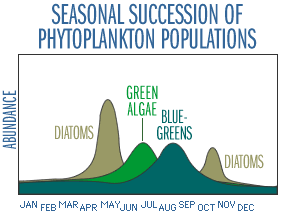 |
 |
A lake’s biological characteristics are determined in large part by physical characteristics of the water column. Important physical characteristics include temperature, light transparency, and wave action, as well as the total abundance of inorganic nutrients, which is largely a watershed characteristic. In addition, preceding populations influence successive populations by assimilating critical nutrients. Populations also have varying susceptibilities to grazing by zooplankton, which vary seasonally in type and abundance. As physical, chemical, and biological conditions in the lake change over time, some species will be effectively eliminated from a lake because they cannot tolerate the new conditions. Other species will be out-competed by organisms that are better adapted to the new environment.
Figure 19
These changes represent an important ecological pattern in lakes known as algal succession. In most natural systems the seasonal succession of algae (and macrophytes) is a recurrent, if not exactly repetitive, yearly cycle. A typical algal succession is shown in Figure 19. Some species flourish for a period of time and then give way to other species more compatible with changed conditions, such as warmer water, more daylight, or lower concentrations of phosphorus or nitrogen. Short-lived plankton communities are characterized by these seasonal fluctuations; longer-lived organisms, such as fish, must be tolerant of lake conditions all year.
